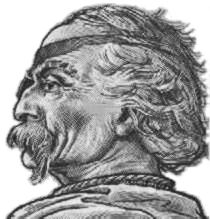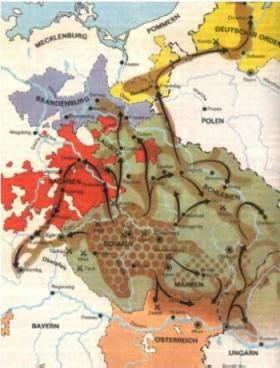This led to conflicts between the church on one side and the czech people on the other, between merchants, craftsmen and the lords who wanted to preserve their privileges, between the peasants who wanted to be free and no longer be serfs and the lords. These conflicts became even more important with prices going up, thus making the rich citizens richer and ruining the peasants and the less wealthy lords. Then there was a national conflict. King Ottokar II and Charles I of Bohemia invited german peasants, craftsmen, artists and miners to come to Bohemia. The majority of the population of the cities of Kuttenberg, Deutschbrod and Iglau were germans. The university of Prague and the catholic church were dominated by germans. Wherever a czech met a german he considered the german as the rich exploiter or the serious competitor. On the other hand most germans were conservative in that they relied upon the existing relations and the power of the church to protect their interests.
![[Jan Hus]](/images/hus.jpg) |
| Jan Hus |
In 1414 the church concile of Constance began, which mainly should elect a new pope (at that time there had been three at the same time) and which should resolve the problem of the czech heretics. This was important because of the serious risk of a disintegration of Bohemia out of the church and the german empire. Emperor Sigismund, the brother of king Wenceslas, was afraid of the influence of Hus and obtained that Hus was invited to the concile under the guarantee of a safe-conduct. Hus accepted, confident that he preached only the truth and that everybody would understand him. Especially, he preached that prelates and bishops should live as poor and simple as the first christians and that mortal sins should be punished without regard of the person.
Indeed everybody understood and, as a consequence, Hus was arrested to force him to repeal his heresy. But as that didn't help he was burned on July 6, 1415. The flame that burned Hus lit the fire in Bohemia.
All over the country revolts began. This movement was called after is symbol, a cup, the Calyxtines. The calyx of the communion was reserved for the priest. Following the ancient traditions, the calyx should have been given also to the community. The Calyxtines wanted among other things re-establish this old custom. A symbol though, as good as any other.
The claims of the Calyxtines were put together in the four Articles of Prague:
The hussite movement consisted of two distinct parts, the moderate Utraquists (utrae means equal, because of the communion in either form) and the radical Taborites (after the town of Tabor which they founded).
The Utraquists were supported mainly by the lords who had taken the land of the church. Though the lords were bound strongly to the hussite movement. Next the rich of Prague, who also had had their profit of the confiscations and later the benefits of the war.
 |
| Jan Zizka |
"In that time there will be no king on earth and no master, nor will there be a subject, and all taxes will have an end, no one will force any other to do something, because they all will be equally brothers and sisters."
"As in the city of Tabor there is no 'mine' and no 'yours', but all is in common, the like it shall be everywhere and nobody shall have a special property, and those who have such property commits a mortal sin."
King Wenceslas tried to oppose the different parties to each other until his brother threatened to invade the country. But when Wenceslas allowed the catholic theologians to return a revolt of the citizens of Prague began. On July 30, 1419 the city was under control of the hussites, their leader was Jan Zizka (1360-1424). It was that day when the first defenestration happened: 7 members of the city council were thrown out of the window of the city hall - and felt into spears put in place to that effect. When Wenceslas heard this he was hit by the stroke and died soon after. Bohemia now was a Republic.
 Secretly, the Utraquists of Prague tried to negotiate with the
emperor Sigismund, without success because the emperor did not accept any
compromise. Pope Martin V was even more harsh when he appealed the whole
Christianity to a crusade against the hussites. This crusade started in
1420 and ended with a withdrawal of the catholic troops, beaten by a peasants
army lead by Jan Zizka. Other "crusades followed, leading the hussite army
to Saxony and the baltic sea in the north, to Hessen and Bavaria in the
west and near Vienna in the south. Jan Zizka died in 1424, but his successor,
the taborite Andrew Prokop (1380-1434) was as skilled as Zizka.
The 4. crusade ended in 1427 at Mies when the imperial troops heard the
war-crys of the hussites. the same happened to the 5. crusade in 1431 at
Taus. After that there wasn't anybody who had enough courage to fight against
the hussites.
Secretly, the Utraquists of Prague tried to negotiate with the
emperor Sigismund, without success because the emperor did not accept any
compromise. Pope Martin V was even more harsh when he appealed the whole
Christianity to a crusade against the hussites. This crusade started in
1420 and ended with a withdrawal of the catholic troops, beaten by a peasants
army lead by Jan Zizka. Other "crusades followed, leading the hussite army
to Saxony and the baltic sea in the north, to Hessen and Bavaria in the
west and near Vienna in the south. Jan Zizka died in 1424, but his successor,
the taborite Andrew Prokop (1380-1434) was as skilled as Zizka.
The 4. crusade ended in 1427 at Mies when the imperial troops heard the
war-crys of the hussites. the same happened to the 5. crusade in 1431 at
Taus. After that there wasn't anybody who had enough courage to fight against
the hussites.
Now intrigues were the last resort for the emperor. He and the pope made important concessions. They tried to divide their enemies, to bring up the moderate Utraquists against the radical Taborites, which means the lords and the rich merchants against the peasants and the craftsmen. The church "generously" abandoned any revenge of the robbery of its lands, the lords kept them for sure. This was exactly what the lords, who had not taken part in the war wanted. Already in the beginning of the movement they took all they wanted. They had no further interest in the hussite movement besides a lasting right on their booty, if possible sealed by the victim and recognized by the emperor. The agreement was settled in 1433 and the lords forced the application through the battle of Liban on May 30, 1434. Even this was only possible because of treason. In this battle 25 000 mercenaries of the army of the lords were opposed to 18 000 Taborites. The battle continued long time without an advantage for any side, when suddenly the taborite cavalry left the battlefield. At the end, among the 18 000 Taborites 13 000 were killed. Their Power was broken.
Suggested Links:
| http://myweb.tiscali.co.uk/matthaywood/main/Hussites.htm | A very detailed Hussite website |
| http://www.zum.de/whkmla/region/germany/bohemiahussites.html | Map of Hussite lands and invasion routes |
| http://www.fragmentsweb.org/stuff/janhus.html | Short essay about Hus and a photo of his statue |
| http://newadvent.org/cathen/07584b.htm | This link was very interesting and it help me find a lot about Jan,Hus |
| http://www.piar.hu/councils/ecum16.htm | Transcript of the Council of Constance 1414-18 including the case against Jan Hus |
John Ball |